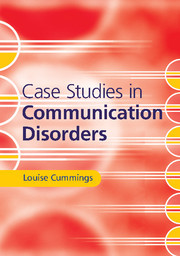Description
Case Studies in Communication Disorders
Author: Cummings Louise
This is a collection of 48 highly useful case studies of children and adults with communication disorders.
Language: English
Subject for Case Studies in Communication Disorders:
Approximative price 120.27 €
In Print (Delivery period: 14 days).
Add to cart
Case Studies in Communication Disorders
Publication date: 10-2016
522 p. · 18x25.5 cm · Hardback
Publication date: 10-2016
522 p. · 18x25.5 cm · Hardback
Approximative price 56.06 €
In Print (Delivery period: 14 days).
Add to cart
Case Studies in Communication Disorders
Publication date: 10-2016
522 p. · 17.3x24.6 cm · Paperback
Publication date: 10-2016
522 p. · 17.3x24.6 cm · Paperback
Description
/li>Contents
/li>Biography
/li>
Designed for students of speech-language pathology, audiology and clinical linguistics, this valuable text introduces students to all aspects of the assessment, diagnosis and treatment of clients with developmental and acquired communication disorders through a series of structured case studies. Each case study includes questions which direct readers to important features of the case that will facilitate clinical learning. A selection of further readings encourages students to extend their knowledge of communication disorders. Key features of this book include: ? 48 detailed case studies based on actual clients with communication disorders ? 25 questions within each case study ? Fully-worked answers to every question ? 105 suggestions for further reading The text also develops knowledge of the epidemiology, aetiology, and linguistic and cognitive features of communication disorders, highlights salient aspects of client histories, and examines assessments and interventions used in the management of clients.
Part I. Speech Disorders: 1. Cleft lip and palate; 2. Developmental dysarthria; 3. Developmental verbal dyspraxia; 4. Glossectomy; 5. Acquired dysarthria; 6. Apraxia of speech; 7. Foreign accent syndrome; Part II. Language Disorders: 8. Developmental phonological disorder; 9. Specific language impairment; 10. Pragmatic language impairment; 11. Developmental dyslexia; 12. Language in intellectual disability; 13.Language in autism spectrum disorder; 14. Language in epilepsy; 15. Language in paediatric traumatic brain injury; 16. Language in childhood cancer; 17. Fluent and non-fluent aphasia; 18. Right-hemisphere language disorder; 19. Language in adult traumatic brain injury; 20. Language in dementia; 21. Language in other neurodegenerative disorders; Part III. Fluency Disorders: 22. Developmental stuttering; 23. Acquired stuttering; 24. Cluttering; Part IV. Voice Disorders: 25. Organic voice disorder; 26. Functional voice disorder; 27. Laryngectomy; 28. Transsexual voice; Part V. Hearing Disorders: 29. Conductive hearing loss; 30. Sensorineural hearing loss; 31. Cochlear implantation; 32. Central auditory processing disorder; Part VI. Psychiatric Disorders: 33. Childhood emotional and behavioural disorders; 34. Schizophrenia; 35. Bipolar disorder; Appendix A. Answers to questions; Appendix B. Suggestions for further reading.
Louise Cummings is Professor of Linguistics at Nottingham Trent University. She is a member of the Royal College of Speech and Language Therapists and is registered with the Health Professions Council in the UK.
© 2024 LAVOISIER S.A.S.




